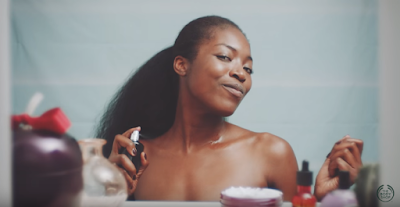This Girl Can (2015) is a campaign by Sport England, the body that allocates public funding to sport, as a way to encourage women of all shapes and sizes to get into sports and activities around the UK. Their official website states describes the campaign:
It’s a celebration of active women up and down the country who are doing their thing no matter how well they do it, how they look or even how red their face gets.
It's inspirational, it's motivational, and more importantly it represents a diverse selection of women, and does not discriminate against any group, whether that be race, age or weight.
The world's best bras. The sexiest lingerie. The most beautiful supermodels.
The company is the largest American retailer of women's lingerie, with 2012 sales of $6.12 billion, and attracts women of a particular demographic.
The promotional video for 'This Girl Can' begins with a shot following a woman in her bikini on her walk to the swimming pool. You do not see her face, or her identity at all; this is often a convention of male-centric advertising, which focuses more on women's sex appeal than women as people. However, this convention is quickly subverted as we are shown a shot of the woman adjusting her bikini bottoms, which portrays the woman as human (as almost every woman has had to straighten their bikini or underwear to reduce discomfort) and less like an object for male pleasure. The nonchalance and confidence with which she does this only adds to the normality of the situation, and suggests that she is perhaps unaware that the video is being shot, therefore is not putting an act on for the cameras.
The Victoria's Secret video also showcases a range of women in their swimsuits, but in contrast to This Girl Can this video is carefully filmed to achieve the flawless image that the brand aims to broadcast. In the particular shot pictured, a woman is shown in her bikini as the water splashes around her. Although you see her face, she appears completely void of all emotion, pouting and looking away from the camera. Her hair is perfectly tousled despite being in the water, and this is obviously constructed by the directors of the video as in reality any woman who has been in the water would have messy, tangled hair and running mascara - this woman's make-up is perfect due to the directors wanting to promote an 'ideal image' of women.

Another way these two videos present women in different ways is through their use of colour and light. The 'This Girl Can' video is colourful and vibrant, using rich colours such as the blue in the background of the pictured image to connote the excitement and passion that these women have for their sports. Certain shots are busy and crowded, with lots of focal points, flashing lights and colours; rather than being distracting or an indication of poor filming, these shots have been carefully constructed to show a flurry of colours and activity associated with active sports such as zumba classes and netball. In contrast, the Victoria's Secret video is particularly bland, with most shots featuring neutral colours like the sand and rock in the pictured image. Rather than presenting women as active, in this video the women are passive, with the neutral colours connoting stillness and calm. The use of light is particularly strategic, drawing the audience's focus to the curves of the women's bodies. Paired with the women's sensual poses, this presents an air of sexuality and suggestivity, with these women seeming little more than objects on display.
***
The purpose of the 'This Girl Can' video is to inspire women to pursue sports both for their health and their enjoyment. Sports are stereotypically 'male' interests, and women who enjoy playing sports are often labelled as 'tomboys' rather than just being regarded as women who play sports. This video subverts these stereotypes and instead presents women with long hair, makeup and painted-pink nails playing sports without compromising their femininity. By broadcasting this video, women across the country could be inspired and invigorated by the presentation of strong and empowered women.
The Victoria's Secret video was produced and broadcast for an entirely different reason. As a business rather than a campaign, their aim is to promote and advertise their products in order to maximise sales and therefore product. Slow, sensual shots in the video show off the designs and colours of the swimsuits, and the poses the models are shown in are suggestive and sexy enough that they appeal to both men and women - men want their girlfriends and wives to look as attractive as the models used in the videos, therefore will buy the swimsuits in an attempt to achieve that, while women want to dress to impress, and buy Victoria's Secret products to feel as attractive as the women wearing them.
































